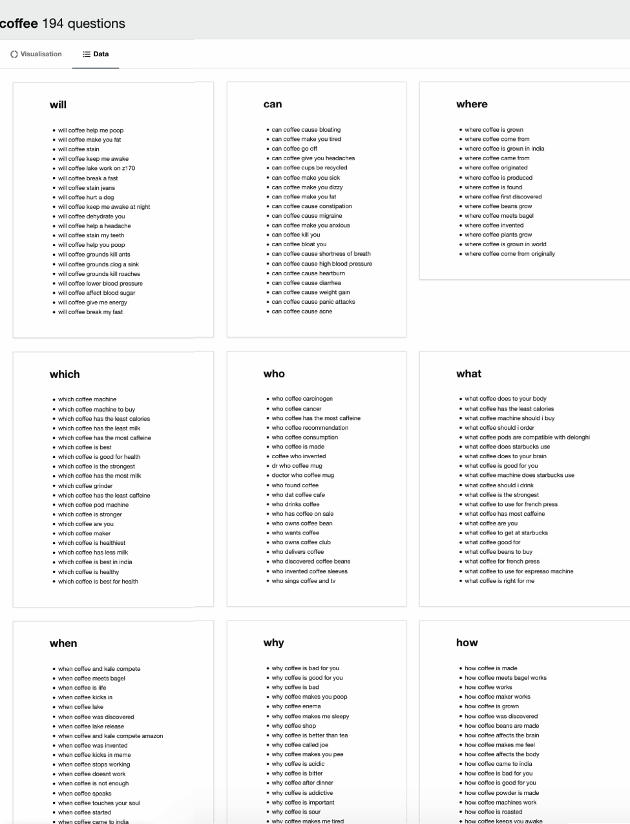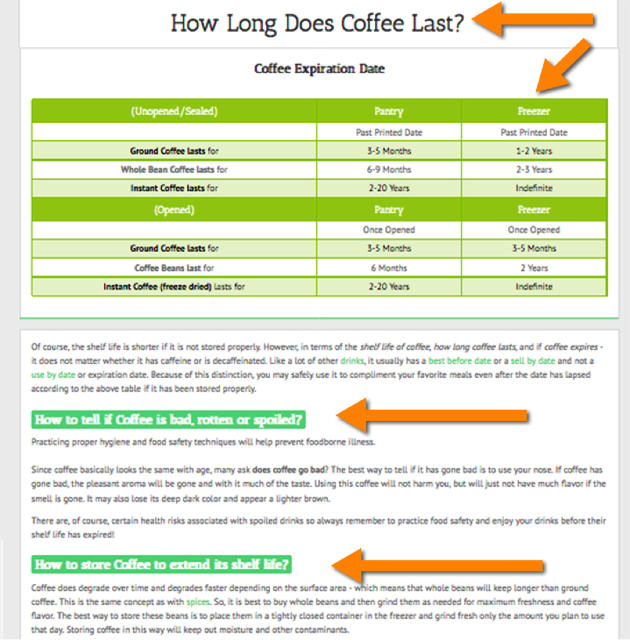Search queries on Google that draw a featured snippet response have almost tripled over the past two years, according to tracking data collected by Moz.
Why should you care?
When your webpage gets the nod from Google and ends up being selected for the Knowledge Graph (let's say), you get top-of-the-page organic placement and all the benefits that such a coveted position offers.
The aim of this article is to demystify featured snippets, and to do so in nontechnical language. I'll talk about the types of featured snippets you can use and discuss how they work. After that, I'll guide you, step-by-step, on how to get started on claiming your spot at the top of the search engine results page (SERP).
Let's get started.
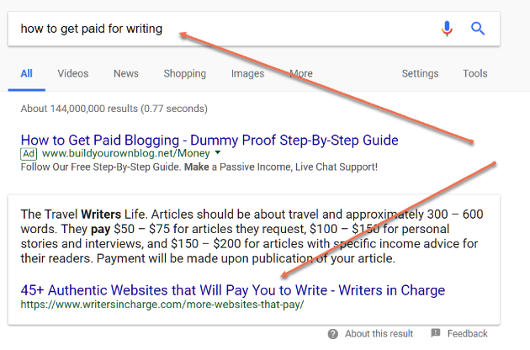
Featured Snippets: Your Fast-Track to More Traffic from Google
Note the Google search query in the screenshot (above). Right below the paid ad (taking up search position zero) is a featured snippet.
What does that prime positioning cost writersincharge.com per click?
Zilch!
How much value can that placement add to the effort to generate organic traffic?
Huge!
If you get your personal or business content in the Google featured snippets answer box, that means you've hit the Google jackpot. And made your competition drool.
But is it possible for you to gain featured snippet status?
If you'll follow the recipe I lay out here, you'll position your content to jump into that spot at the first available opportunity.
Your time is coming. Maybe sooner than you think.
Here's What Happens to Traffic When Your Featured Snippet Gets Selected
When the featured snippet was launched (in 2014), the first thing most search marketers noticed was that it pushed the No. 1 organic return on the search engine results page (SERP) farther down the page—effectively creating a No. 0 placement above the No. 1 spot.
Many site owners complained about the move, because it diminished the impact of their hard-earned organic placements on SERPs. Google had already begun stacking ads above organic results, so above-the-fold real estate (i.e., part of the page which you see before scrolling down) was already shrinking.
But smart marketers know that every problem presents an opportunity. In this case, the opportunity is to take the featured snippet placement away from your competitor and jump to the very top of organic search results.
Here are some smart bloggers who shared their stats after getting featured on SERPs:
- Stonetemple.com's traffic increased 20-30% after the site got featured
- Ben Goodsell shares that the CTR from search results to his page increased 6% once it was featured—and the revenue from those clicks increased over 600%.
So let's look at how you can score big time.
How to Earn Your Spot in Google Featured Snippets
There's no luck involved: To get your content placed in a featured snippet, you're going to have to earn it.
Fortunately (for you), the competition is not too massive yet. Most people are not aware of this opportunity. Even if they see themselves (or others) featured, they don't know how they got there.
The big mistake people make is to assume the featured snippet is synonymous with the No. 1 organic result. That's definitely not the case (more about that later).
Follow the following steps, and you'll be well positioned to occupy the featured-snippet throne.
Step 1: Determine the Queries Best Suited to Your Topic
Notice I said "queries," not "query."
That's because you'll be uncovering a ton of nuggets in the process of choosing the ones best for you. Start a list. Once you go through this process the first time, you can do it over and over again to keep shooting arrows at the featured snippet target.
In the strategy outlined here, your aim is to determine the questions searchers are asking (relative to your niche), consider the competition for those queries, and pick the first one you want to go after.
You'll then create the content (bait) that will woo Google into choosing you for the prom. Certainly, this process can be reverse-engineered (consider your current content and work backwards), but beginning with keyword research is the most direct route.
How to Choose the Featured Snippet Queries Best Suited to Your Blog or Brand
You'll want to come at the selection process from every angle you can find. I'm going to list my favorites here, but it won't be an exhaustive list. Its aim is to jump-start your thinking and enthusiasm.
Start by finding out where your website content ranks now for popular queries. The closer you already are to the goal, the quicker and easier you'll probably get there (depending on the competition for each keyword).
Let me say this once again: The higher you rank for a particular query, the better your odds are to get featured. So start with your top-most rankings.
1. Look at your Google Search Console stats first
Google Search Console (formerly Google Webmaster Tools) shows which queries send you traffic (see the screenshot below). Go to "Search Traffic" > "Search Analytics":
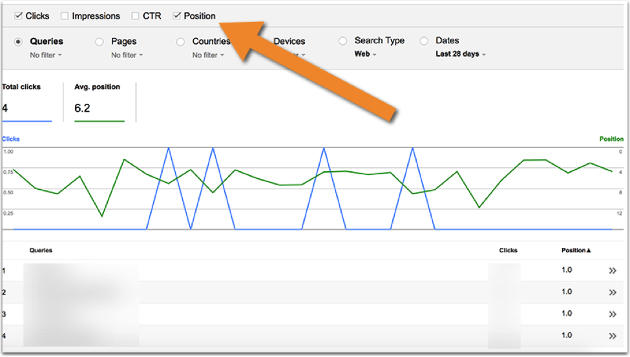
Google Search Console (see the screenshot above) can unveil current positions for popular queries:
- The more clicks you get, the more popular the query is likely to be.
- The higher your position, the better your chances are to get featured.
Multiple studies on rich snippets confirm most featured snippets show up for longtail queries. In fact, the longer the keyword, the higher chances are that Google will respond with a featured snippet.
So start with longer, more popular queries for which you rank in the top 5.
2. Break out your favorite keyword tool
Use your keyword tool to determine which queries are most popular with your target audience. Query exploration is best launched with the help of an old friend—your favorite keyword tool. I prefer Serpstat for this work, but you should use whichever tool you're most comfortable with (both SEMrush and Ahrefs also provide solid keyword-research features).
Type in your core term (i.e., the main topic of your site) and then use filters to find queries that already trigger featured snippets:
Filter > Special elements in SERP > Featured Snippets
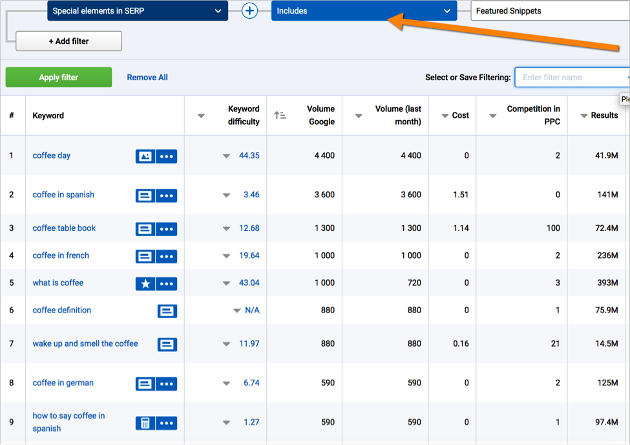
You should also do some spying on competitors to see which keywords are most profitable for them. Do the same exercise I described above, but use the competitor's domain instead of your core term to search:
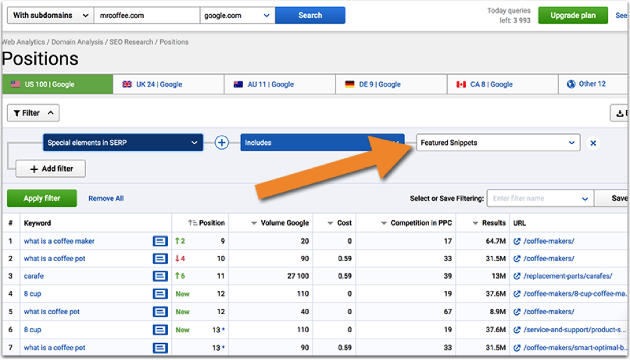
Now what to do with those results?
- Scroll down the list of all the provided keyword strings and pick the ones that you feel suit your blog best.
- Pay attention to "keyword difficulty" column, which shows you how difficult it will be for you to rank for any of these terms high enough to get featured (again, our goal is to rank in the top 5).
I usually recommend staying away from search queries with keyword difficulty higher than 20. You can sort all the results to see the "easiest" queries on top to focus on those:
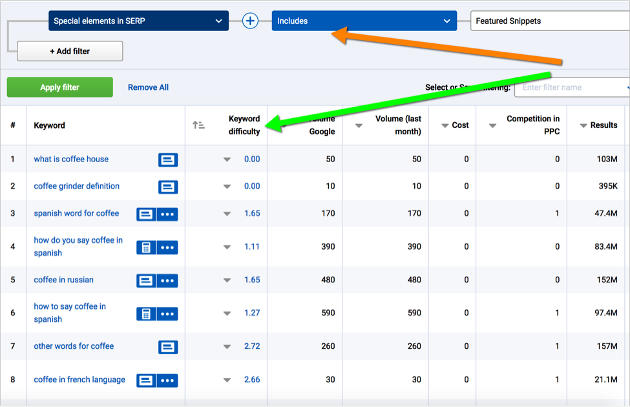
3. Check the suggestions in 'People also ask'
While you are there scrolling through keyword lists, make sure you actually search for each phrase that looks good to you. Apart from general idea of who you are going to compete with, doing so will also provide you with more ideas because many queries that trigger featured snippets also show another useful special search element: the "People also ask" box (see the screenshot, below).
Look at those carefully to get ideas and find related keywords.
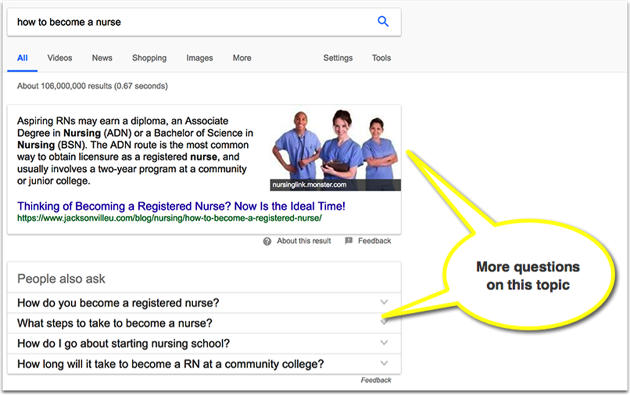
4. Ask the Big 3 to tell you what they think
Another excellent tool for finding long-tail keywords is Answer the Public. It pulls data from Google Suggest to deliver a list of the most popular questions people tend to type into Google's Search Box.
Of course, you could do this manually by entering queries and checking Google, Amazon, and YouTube auto-suggest for a few hours. Keyword Researcher makes that work a whole lot quicker and easier, though.
Again, scroll through the questions and choose the ones you want to create content around. You can use Search Console to find whether you currently rank anywhere for any of those question-type queries:
Open up Google Search Console again. Go through the same procedure mentioned earlier (Search Traffic > Search Analytics > Position), then pull down options under "Queries" (see screenshot below).

That will give you the option to enter the keywords (and individual words from the keyword phrases) to find your current positions on the SERP for those keywords (see the screenshot below).

Google Search Console (see above) lets you filter queries to determine where you're ranking for select keywords now.
Tip: Google Search Console is one powerful and fascinating tool. Check it out!
Don't Forget About Your Own Customers
Keyword tools and Google search may give you a good glimpse of popular questions in your industry, but don't stop there. Your main source of keyword inspiration is your own customer base, because your customers are the ones you want to best serve.
Set up a system that would allow you to record questions your customers are asking and the struggles they are having on a regular basis; then, turn to that archive whenever you are working on your content editorial calendar. I use Salesmate to make sure my team and I are noting all customers' questions and keeping a good record of them:
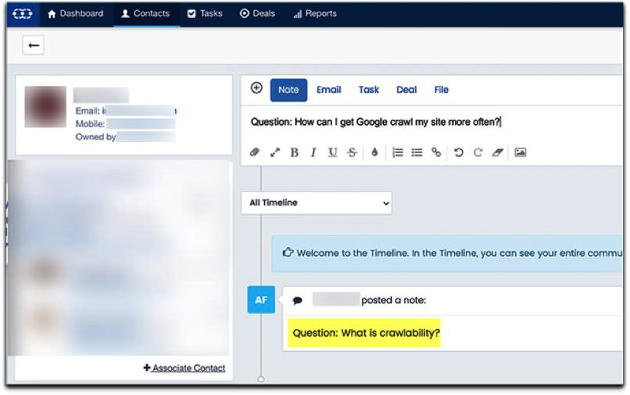
You can expand those customer-generated keywords using keyword research tools listed above, but make these specific topics your priority.
The More You Research, the More You Organize
Using the tools I've noted above, you are likely to find hundreds of keywords you'll want to target. So that you don't get overwhelmed, make it a rule to organize those keywords from the very start.
I use Excel spreadsheets to organize search queries I am going to target. Here are some pointers on how to do that:
- The main query is the topic of the future article.
- More specific keywords are used as the subheadings.
- Keywords that express pretty much the same ideas are noted and used in-content if possible.
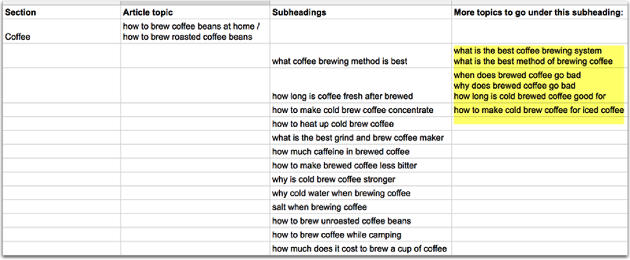
You can also use the same spreadsheet to note other things, like whether you are going to write a new article or optimize an old one, which type of content you plan create to target it, and whether it's seasonal:

You can incorporate both of these organizational techniques in one Excel spreadsheet, noting each article structure and then drafting content editorial calendar based on your research.
Let's recap step No. 1. This is the process I've suggested for determining which queries you want to grab for Google featured snippet placement:
- Break out your favorite keyword tool (especially the one that allows you to filter queries by those that trigger featured snippets and show the "difficulty" of each keyword).
- Check the suggestions in "People also ask" and Google Suggest (through tools like Answer the Public).
- Identify longtail keywords relative to your niche where the competition isn't all that fierce (use the "keyword difficulty" metric for that).
- Identify content that's ranking in the top 10 of the SERP for the keywords you've identified using Search Console.
- or decide whether you need to create new content for any of the chosen queries. (How to decide? If you don't have an article covering this topic but you feel it's something you'd be excited to blog about, go for it! Especially if it looks like the competition is not too high, based on the keyword difficulty.)
- Use Excel to record and organize keywords you are going to target.
Suggested resources for keyword research:
- 61 Experts Reveal Best Tools for Keyword Research
- 7 Steps to Finding the Best Evergreen Content Ideas
- How to Find Most Valuable Keywords to Create Content
Once you've chosen the most promising longtail keyword (based on how relevant it is to your niche, how much opportunity exists for that keyword, and how close you are currently with necessary content), you're ready to begin optimizing.
So let's move on to Step No. 2.
Step 2: Optimize Your Content for Those Keywords and Questions
In this step, you'll optimize your website and content to help Google identify your content as the best possible answer to one or more questions.
Begin with on-page SEO
There's specific coding that will ensure the featured placement. You should, though, start with fundamental SEO best-practices. That's because you almost certainly need to be ranking in the top 10 of the SERP before you stand a chance of getting featured.
Suggested resources for SEO:
- A 14-point Checklist for a SEO-Happy Website Launch
- How to Make Your Content Findable (with Randy Milanovic)
- For those using WordPress, a comprehensive and up-to-date list of essential plugins for SEO
Answer the question concisely
Google prefers concise paragraphs, and a paragraph-style featured snippet is 45 words long (293 characters) on average, and the maximum is 97 words (752 characters). So, you'll want to get to the point quickly. That said, make sure the entire paragraph is 100 words or more; you'll want searchers to need to click through to see the rest of the answer.
Organize the answer properly
Here's the paragraph format I suggest:
- Use the subheading or first line of the paragraph to place the question (i.e., make the query you want to answer for Google featured-snippet placement).
- Give your ~100-word answer below that.
- Expand on the topic below that. Your query answer should be part of a larger work related to the topic.
- Bonus step: If it's an already-published article, republish it with the new date for it to show up on top of your blog archive.
For example, I managed to snatch a featured snippet placement from a competitor when I changed my article structure as follows:
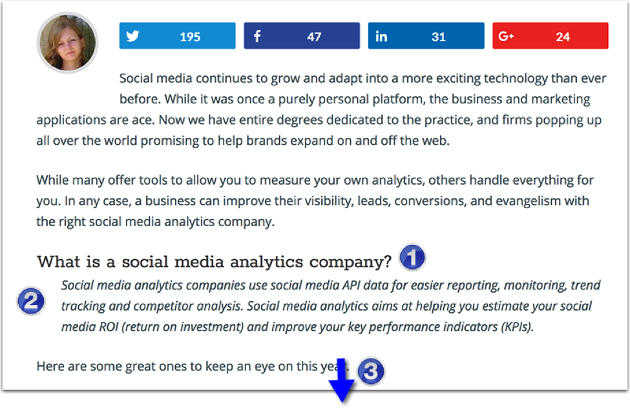
Remember: Be factual, direct, and specific in your answer.
Here's my simple technique explained in a bit more detail:
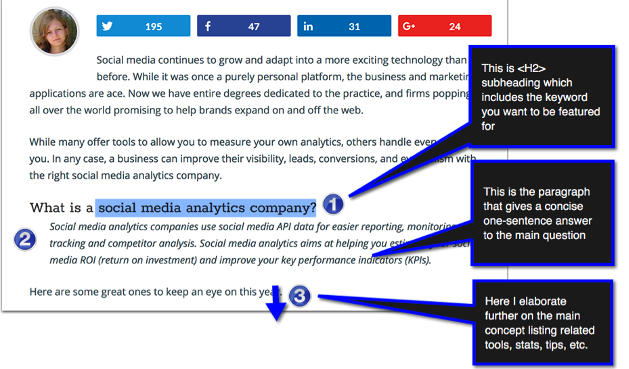
Use one article to answer many related questions
When a page gets featured once, it has more chances of getting featured for similar queries. This is where your keyword list comes in handy.
Here's an example of an article being featured for several related questions thanks for its effective structure. Notice:
- It starts with factual data (in the form of a table).
- There are various related questions in the subheadings (with short factual answers provided for each one):
Use optimized images
Many featured snippets include an image from the featured page, which obviously boosts click-through and brand-exposure dramatically. Sometimes Google even features an image from a different page when it's unable to find a good image on the featured page. Don't let that happen! Always include high-quality, well-branded images next to the question you are optimizing for.
You might try Bannersnack to create high-quality branded images.
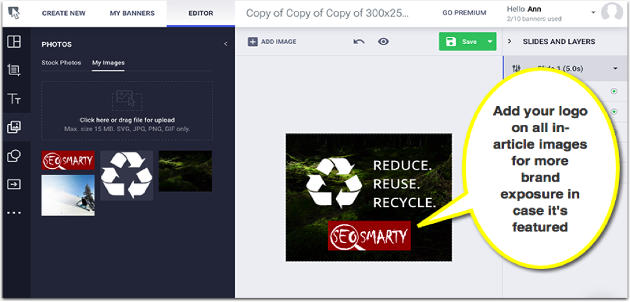
Going through these steps will help you grab a Google featured snippet position; moreover, learning to draw out content in the ways noted above can help you become a better writer, in general. They've certainly helped me.
Step 3: Don't Stop There
This isn't meant to be a one-time-through sort of article. Bookmark it and keep it for reference. Just as the best time to run A/B tests is "always," the best time to optimize for Google featured snippets is "whenever you write a blog post or an article."
Staying attuned to the importance of ranking organically and nailing down the goal of being featured in "position zero" provides additional benefits too, including more content ideas and better tools to understand your audience.
All told, a win-win proposition.
Content listed as a featured snippet is there because it does the best job of answering a specific question. You're helping Google provide better results, you're helping the searcher find the best results, and you're helping your brand catch on fire.
Don't stop doing that.
